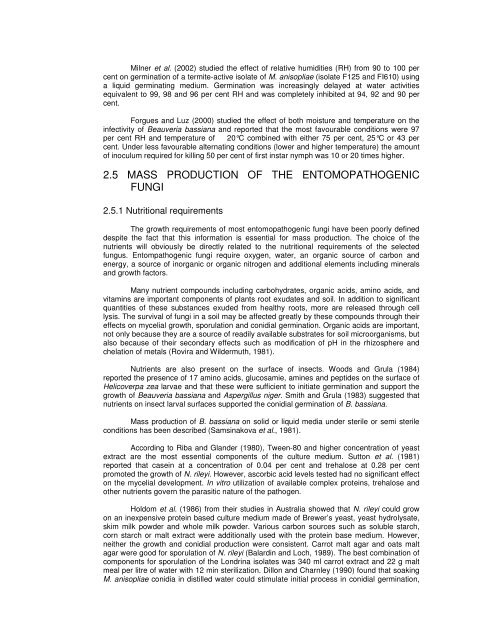ISOLATION AND CHARACTERIZATION OF ENTOMOPATHOGENIC ...
ISOLATION AND CHARACTERIZATION OF ENTOMOPATHOGENIC ...
ISOLATION AND CHARACTERIZATION OF ENTOMOPATHOGENIC ...
Create successful ePaper yourself
Turn your PDF publications into a flip-book with our unique Google optimized e-Paper software.
Milner et al. (2002) studied the effect of relative humidities (RH) from 90 to 100 per<br />
cent on germination of a termite-active isolate of M. anisopliae (isolate F125 and FI610) using<br />
a liquid germinating medium. Germination was increasingly delayed at water activities<br />
equivalent to 99, 98 and 96 per cent RH and was completely inhibited at 94, 92 and 90 per<br />
cent.<br />
Forgues and Luz (2000) studied the effect of both moisture and temperature on the<br />
infectivity of Beauveria bassiana and reported that the most favourable conditions were 97<br />
per cent RH and temperature of 20°C combined with either 75 per cent, 25°C or 43 per<br />
cent. Under less favourable alternating conditions (lower and higher temperature) the amount<br />
of inoculum required for killing 50 per cent of first instar nymph was 10 or 20 times higher.<br />
2.5 MASS PRODUCTION <strong>OF</strong> THE <strong>ENTOMOPATHOGENIC</strong><br />
FUNGI<br />
2.5.1 Nutritional requirements<br />
The growth requirements of most entomopathogenic fungi have been poorly defined<br />
despite the fact that this information is essential for mass production. The choice of the<br />
nutrients will obviously be directly related to the nutritional requirements of the selected<br />
fungus. Entompathogenic fungi require oxygen, water, an organic source of carbon and<br />
energy, a source of inorganic or organic nitrogen and additional elements including minerals<br />
and growth factors.<br />
Many nutrient compounds including carbohydrates, organic acids, amino acids, and<br />
vitamins are important components of plants root exudates and soil. In addition to significant<br />
quantities of these substances exuded from healthy roots, more are released through cell<br />
lysis. The survival of fungi in a soil may be affected greatly by these compounds through their<br />
effects on mycelial growth, sporulation and conidial germination. Organic acids are important,<br />
not only because they are a source of readily available substrates for soil microorganisms, but<br />
also because of their secondary effects such as modification of pH in the rhizosphere and<br />
chelation of metals (Rovira and Wildermuth, 1981).<br />
Nutrients are also present on the surface of insects. Woods and Grula (1984)<br />
reported the presence of 17 amino acids, glucosamie, amines and peptides on the surface of<br />
Helicoverpa zea larvae and that these were sufficient to initiate germination and support the<br />
growth of Beauveria bassiana and Aspergillus niger. Smith and Grula (1983) suggested that<br />
nutrients on insect larval surfaces supported the conidial germination of B. bassiana.<br />
Mass production of B. bassiana on solid or liquid media under sterile or semi sterile<br />
conditions has been described (Samsinakova et al., 1981).<br />
According to Riba and Glander (1980), Tween-80 and higher concentration of yeast<br />
extract are the most essential components of the culture medium. Sutton et al. (1981)<br />
reported that casein at a concentration of 0.04 per cent and trehalose at 0.28 per cent<br />
promoted the growth of N. rileyi. However, ascorbic acid levels tested had no significant effect<br />
on the mycelial development. In vitro utilization of available complex proteins, trehalose and<br />
other nutrients govern the parasitic nature of the pathogen.<br />
Holdom et al. (1986) from their studies in Australia showed that N. rileyi could grow<br />
on an inexpensive protein based culture medium made of Brewer’s yeast, yeast hydrolysate,<br />
skim milk powder and whole milk powder. Various carbon sources such as soluble starch,<br />
corn starch or malt extract were additionally used with the protein base medium. However,<br />
neither the growth and conidial production were consistent. Carrot malt agar and oats malt<br />
agar were good for sporulation of N. rileyi (Balardin and Loch, 1989). The best combination of<br />
components for sporulation of the Londrina isolates was 340 ml carrot extract and 22 g malt<br />
meal per litre of water with 12 min sterilization. Dillon and Charnley (1990) found that soaking<br />
M. anisopliae conidia in distilled water could stimulate initial process in conidial germination,
















